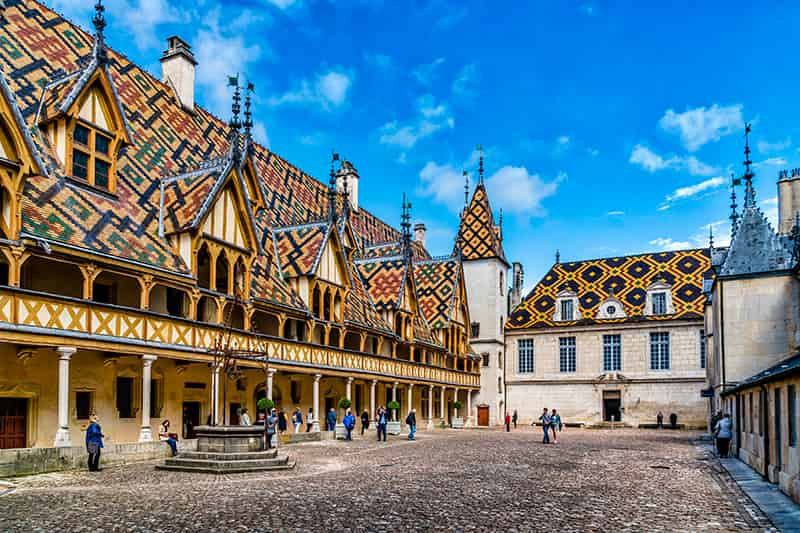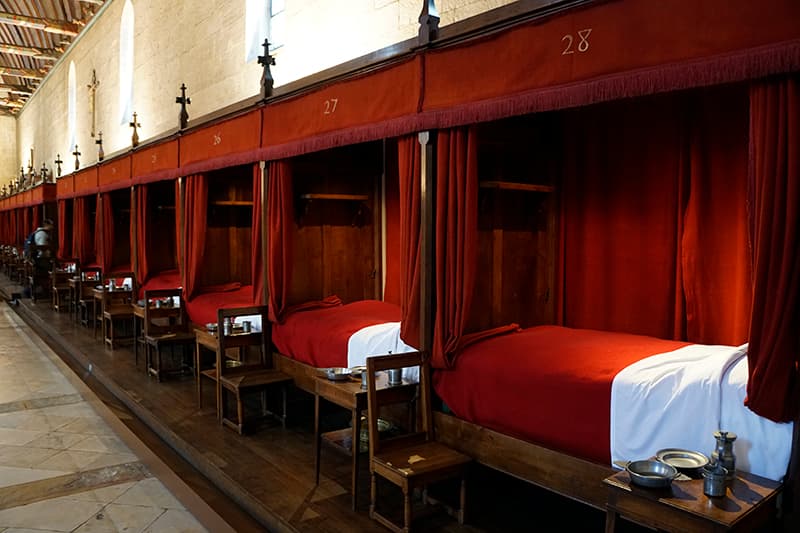The Hospices de Beaune, also known as the Hôtel-Dieu Hospice is iconic to the Burgundy region. Stepping over the threshold is like tiptoeing into a Gothic fairy tale. Half-timbered structures rise from a central cobbled courtyard, lined with elaborate tiled roofs and spired dormer windows. The coloured roofs shimmer in an afternoon of sunlight, highlighting the tiles of yellow, red, green, and black.
At first glance, this stunning medieval building could be an ostentatious manor, but its true purpose was much more understated. Uninterrupted for over 500 years, the Hospices de Beaune provided the poor with a place to rest their heads and receive vital medical treatments.
Based within the Burgundian town of Beaune, the Hospices de Beaune has a lesser-known secret. Its services were funded by the sale of some of Burgundy’s most exclusive wines. Read on to find out more about this incredible part of French heritage and to see what is waiting to be discovered on a cruise aboard hotel barges L’Impressioniste and Finesse.
What is the Hospices de Beaune in Beaune?
Founded in 1443 against a backdrop of devastation and plague, the Hospices de Beaune provided a place for the poor to receive the care and treatment they needed. The One Hundred Years War, which has been fought between the French and English, had left France in a sorry state. War had caused high taxation, marauding and pillaging, and resulted in mass poverty.
It was the Duke of Burgundy’s Chancellor, Nichlos Rolin, who responded to this societal problem by vowing to care for the destitute in the Hospices de Beaune. He founded the hospice with his beloved wife, Guigone de Salins. Permission from the Pope was sought to consecrate the new hospices and the charitable building was named ‘Hôtel-Dieu’, which directly translates as ‘hostel of God’.
At the time when the Hospices de Beaune was founded, Burgundy was ruled by Duke Philip the Good, who was known for his patronage of the arts. During this period, many talented Flemish artists arrived in Burgundy. The construction works at the Hospices de Beaune were possibly overseen by the Flemish architect, Jacques Wiscrère.
Opening its doors to the poor in 1452, the aim of the Hospices de Beaune was to cure its patients of their ailments, whether they were physical or spiritual. The Hospices de Beaune served as a hospital until 1971, when a new building was erected just outside of Beaune.
How was the Hospices de Beaune funded?
During the Middle Ages, religion was a prominent part of daily life. Whether people were rich or poor, they sought to make their peace with God to gain admission into heaven when they died. Life expectancy was significantly lower than they are today, and many Europeans didn’t live past the age of 33. The threat of death was ever-present and those that had the means would donate money to the Catholic Church as good deeds, so that their soul would be looked upon kindly at ‘Judgment Day’.
Many wealthy Burgundian citizens donated property and money to the Catholic Church and its charities. This resulted in the Hospices de Beaune accruing land, art, and most importantly, vineyards. The Hospices de Beaune’s location in Burgundy perhaps meant it acquired the very best assets in France from its wealthy patrons. In fact, the vineyards it owned meant it was able to make an annual income from wine and fund the services and maintenance of the hospices.
What is so special about the Hospices de Beaune’s Wines?
The Hospices de Beaune possesses some of the most prestigious vineyard appellations in the whole of the Burgundy region. The very first vineyard donation came from Guillemette Levernier in 1457, and so began the tradition of growing and harvesting grapes at the Hospices de Beaune. The estate of vineyards now occupies over 60 hectares of land, of which 50 produce Pinot Noir and 10 produce Chardonnay.
Most wines made from the Hospices de Beaune estates are either premier crus or grands crus, which are extremely sought after by wine connoisseurs. Created by exceptional winemakers, the wines are auctioned every year on the third Sunday of November by Sotheby’s. This charity wine auction is the most famous wine auction in the world and wines sold here are coveted by wine lovers globally.
The famous wine auctions of the Hospices de Beaune are the highlight of a special three-day festival in Burgundy that celebrates the wines and gastronomy of the region. Celebrated by local people, wine lovers, and tourists, the festival marks the end of the harvest and the beginning of the sale of the year’s vintages.
What can I see at the Hospices de Beaune?
The impressive, vaulted ceilings inside the hospice de Beaune look like the bottom of a ship’s hull. Their impressive beams line the Salle des Pauvres, which translates as ‘Room of the Poor’. The main halls show the many hospital beds that line the outside of the room, each with its own red curtain and bedding. This room has been immaculately preserved to allow you to experience the hospice as it once would have been.
Visit the great medieval kitchens with their many fireplaces. In the apothecary’s shop, which was tended to by a pharmacist, you will see the many mortar and earthenware vessels used to prepare medicines to cure patients’ ailments. Horrifying medieval medical instruments can also be seen on display here, and they’re enough to make even the toughest visitor’s stomach turn!
Much of the artwork that lines the walls of the Hospices de Beaune can be attributed to some of the best artists of the Middle Ages. A highlight is the polyptych altar panel of the Last Judgement, which was commissioned from the Northern Renaissance artist, Rogier Van der Weyden. The Hospices de Beaune show some of the finest artwork from this period thanks to its founder, Nicholas Rolin, who was a patron of the arts.
Visit the Hospices de Beaune with European Waterways
Visit the historic town of Beaune as part as cruise along the Burgundy Canal with one of our luxury barges, L’Impressionniste or Finesse. Drift down the calm waters and take in the sights and smells of the French countryside, whilst you enjoy a glass or two of the finest Burgundy wines.
If you’d like to find out more about visiting Burgundy with us, then why not view L’Impressionniste or Finesse’s full itinerary? It includes a private guided tour of the Hospices de Beaune, time to explore the town of Beaune itself, and so much more, besides!
 English
English
 Spanish
Spanish French
French German
German Norwegian
Norwegian Portuguese
Portuguese Swedish
Swedish Italian
Italian Russian
Russian Simplified Chinese
Simplified Chinese Japanese
Japanese

